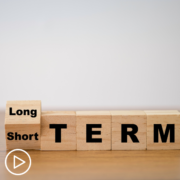AML Treatment Approaches Expand for Older and High-Risk Patients
AML Treatment Approaches Expand for Older and High-Risk Patients from Patient Empowerment Network on Vimeo.
How have acute myeloid leukemia (AML) treatment approaches expanded for older and high-risk patients? Dr. Naval Daver from the University of Texas MD Anderson Cancer Center shares insight about additional treatment options. Learn about the potential for long-term cures for these patient groups.
[ACT]IVATION TIP from Dr. Daver: “There is a dramatic progress, especially in the treatment of older unfit AML with the approval of the azacitidine-venetoclax combination.”
Download Resource Guide en español
Related Resources:

Long-Term Effects Acute Myeloid Leukemia Patients Should Know |

|
Transcript:
Art:
Dr. Daver, for older and high-risk AML patients, how are the treatment approaches expanding?
Dr. Naval Daver:
In older and high-risk AML, the major approval has been the combination of azacitidine (Onureg or Vidaza) and venetoclax (Venclexta), which is a BCL-2 inhibitor, the regimen was evaluated in a large Phase III study called the VIALE study, where we looked at the standard of care for the last two decades for older unfit AML, which azacitidine alone versus the combination of azacitidine and venetoclax and this combination showed a three times higher remission rate, 75 versus 28 percent overall remission rate as well as an improvement in overall survival and long-term survivors.
So this has led to great progress with now remission rates of 75 percent achievable in older unfit AML and many of them being durable at three years with ongoing follow-up, so this has really opened the door for us to be able to treat patients up to 75, 80, 85 years of age with effective therapy given the three parts of these to achieve remission, which is usually associated with freedom from transfusion improvement, quality of life, improved energy, less time in the hospital, less infections.
The other progress now is coming from the use of targeted therapies as well in these populations, and even though the HMA venetoclax or azacitidine combination is doing very well.
We now have data, in fact, from the ASH 2022 December meeting that at three years, about 25 percent or so I would still remain alive with azacitidine was even or 8 percent, now it’s 25 percent. But, of course, we want to do much better than that, and so this is where we are incorporating the targeted therapies, the FLT3 inhibitors, the IDH1, IDH2 inhibitors, menin inhibitors, and immunotherapies onto the backbone of azacitidine-venetoclax, which we hope will further improve that long-term survival cure from 25 to hopefully 50 to 60 percent and beyond.
So a lot of progress, you know, going from less than 10 percent, a 30 percent survival, long-term, and I think in the next few years, even up to 50 percent with some of these new combinations. The activation tip related to this question is that there is a dramatic progress, especially in the treatment of older unfit AML with the approval of the azacitidine-venetoclax combination.
This regimen is now giving high remission rates, which approximate remission rates that are seen with traditional intensive chemotherapy without the mucositis and toxicities and better volatility, and we are now working to further improve the remission and the durability of this dominant of initial.
…potentially adding targeted therapy such as FLT3 inhibitors, IDH1, IDH2 menin inhibitors, and we think that potentially in the next decade, we could be achieving long-term cures in a large proportion of older unfit AML, which was something one could just dream of a decade ago.




